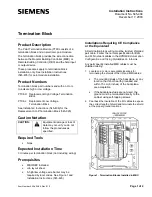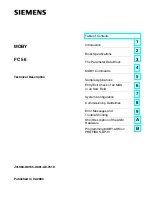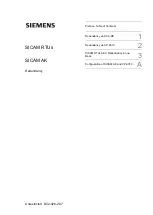
3-3
Section
Screen Display and Notification
294
•
9999:
Return to the previous screen
For details of the setting for bit memory tables, refer to
2-3-3 Bit Memory T
ables
(page 75).
Reference:
S
To display overlapping screens, specify the screen number of a parent screen.
S
The screen is not switched if elements have not been registered to the speci-
fied screen number.
2. When creating the screen, register an alarm list/history element for it.
For details of the alarm list/history, refer to
2-11 Alarm List, Alarm History
(page 173).
Operation
1, 2, 3...
1. If the specified allocated bit in the host changes to 1 (ON) while the element
of the alarm list/history is displayed, the corresponding message is dis-
played (with the alarm list, the message is deleted from the list if the allo-
cated bit returns to 0 (OFF)).
2. The message area is a touch switch and the set image data/library data is
displayed when the touch switch is pressed. The message is displayed in
reverse video at the same time.
3. The screen is switched to the specified screen when the reversed message
is pressed again.
Reference:
S
The description above applies to the case where both the image/library code
and the screen numbers are set in the bit memory table. If the image/library
code is not set, the screen is switched over the first time the message is
pressed.
S
The PT screen is switched when the reversed message is pressed. The screen
is not switched if the status of the allocated bit changes from 1 (ON) to 0 (OFF).
S
When the screen is switched by operation at the PT, the screen switching
strobe of the PT status notify bit changes to 1 (ON) so that the event of screen
switching is notified to the host. The screen number of the new screen is written
to the screen switch setting word in the PT status control area at the same time.
(page 295)
S
When NT30/620 compatible mode is being used, the current screen number
occupies the first word of the PT status notify area and the word containing the
PT status notify bits is shifted down one word. (Refer to page 441.)
For an example of use of screen switching using the alarm list/history function,
refer to
3-8 Using the Alarm List/History Function (page 337).
Example of Use
electronic components distributor
Summary of Contents for NT21 Series
Page 3: ...iv Downloaded from Elcodis com electronic components distributor...
Page 5: ...vi Downloaded from Elcodis com electronic components distributor...
Page 463: ...Downloaded from Elcodis com electronic components distributor...
Page 465: ...Downloaded from Elcodis com electronic components distributor...
















































